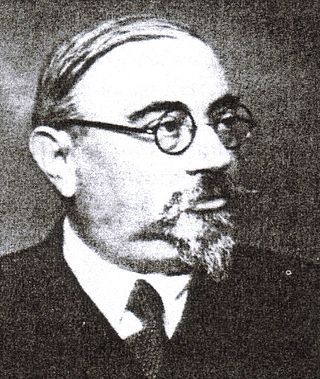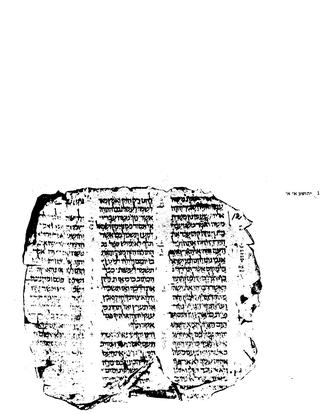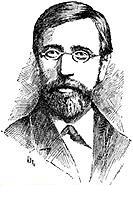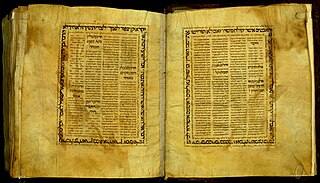
The Masoretic Text is the authoritative Hebrew and Aramaic text of the 24 books of the Hebrew Bible (Tanakh) in Rabbinic Judaism. The Masoretic Text defines the Jewish canon and its precise letter-text, with its vocalization and accentuation known as the mas'sora. Referring to the Masoretic Text, masorah specifically means the diacritic markings of the text of the Hebrew scriptures and the concise marginal notes in manuscripts of the Tanakh which note textual details, usually about the precise spelling of words. It was primarily copied, edited and distributed by a group of Jews known as the Masoretes between the 7th and 10th centuries of the Common Era (CE). The oldest known complete copy, the Leningrad Codex, dates from the early 11th century CE.

The Samaritan Torah, also called the Samaritan Pentateuch, is a text of the Torah written in the Samaritan script and used as sacred scripture by the Samaritans. It dates back to one of the ancient versions of the Hebrew Bible that existed during the Second Temple period, and constitutes the entire biblical canon in Samaritanism.

The Aleppo Codex is a medieval bound manuscript of the Hebrew Bible. The codex was written in the city of Tiberias in the tenth century CE under the rule of the Abbasid Caliphate, and was endorsed for its accuracy by Maimonides. Together with the Leningrad Codex, it contains the Ben-Asher masoretic tradition.
Aaron ben Moses ben Asher was a sofer who lived in Tiberias. He perfected the Tiberian system of writing vowel sounds in Hebrew. The system is still in use today, serving as the basis for grammatical analysis.

Tiberian Hebrew is the canonical pronunciation of the Hebrew Bible (Tanakh) committed to writing by Masoretic scholars living in the Jewish community of Tiberias in ancient Galilee c. 750–950 CE under the Abbasid Caliphate. They wrote in the form of Tiberian vocalization, which employed diacritics added to the Hebrew letters: vowel signs and consonant diacritics (nequdot) and the so-called accents. These together with the marginal notes masora magna and masora parva make up the Tiberian apparatus.

Umberto Cassuto, also known as Moshe David Cassuto, was an Italian historian, a rabbi, and a scholar of the Hebrew Bible and Ugaritic literature, in the University of Florence, then at the University of Rome La Sapienza. When the 1938 anti-Semitic Italian racial laws forced him from this position, he moved to the Hebrew University of Jerusalem.

The Leningrad Codex is the oldest complete manuscript of the Hebrew Bible in Hebrew, using the Masoretic Text and Tiberian vocalization. According to its colophon, it was made in Cairo in 1008 CE.

The Codex Cairensis is a Hebrew manuscript containing the complete text of the Hebrew Bible's Nevi'im (Prophets). It has traditionally been described as "the oldest dated Hebrew Codex of the Bible which has come down to us", but modern research seems to indicate an 11th-century date rather than the 895 CE date written into its colophon. It contains the books of the Former Prophets and Latter Prophets. It comprises 575 pages including 13 carpet pages.
Jewish printers were quick to take advantages of the printing press in publishing the Hebrew Bible. While for synagogue services written scrolls were used, the printing press was very soon called into service to provide copies of the Hebrew Bible for private use. All the editions published before the Complutensian Polyglot were edited by Jews; but afterwards, and because of the increased interest excited in the Bible by the Reformation, the work was taken up by Christian scholars and printers; and the editions published by Jews after this time were largely influenced by these Christian publications. It is not possible in the present article to enumerate all the editions, whole or partial, of the Hebrew text. This account is devoted mainly to the incunabula.

Israel Yeivin was an Israeli linguist, scholar of Masorah and the Hebrew language.
The Jerusalem Crown is a printed edition of the Tanakh printed in Jerusalem in 2001, and based on a manuscript commonly known as the Aleppo Crown). The printed text consists of 874 pages of the Hebrew Bible, two pages setting forth both appearances of the Ten Commandments each showing the two different cantillations - for private and for public recitation, 23 pages briefly describing the research background and listing alternative readings, a page of the blessings - the Ashkenazic, Sefardic and Yemenite versions - used before and after reading the Haftarah, a 9-page list of the annual schedule of the Haftarot readings according to the three traditions.

Seligman (Isaac) Baer (1825–1897) was a Masoretic scholar, and an editor of the Hebrew Bible and of the Jewish liturgy. He was born in Mosbach, the northern district of Biebrich, on 18 September 1825 and died at Biebrich-on-the-Rhine in March 1897.

David Solomon Sassoon, was a bibliophile and grandson of 19th century Baghdadi Jewish community leader David Sassoon. Born in Bombay to Solomon and Flora Sassoon, David and his mother Flora moved to London in 1902, after his father's death in 1894.

Yemenite scrolls of the Law containing the Five Books of Moses represent one of three authoritative scribal traditions for the transmission of the Torah, the other two being the Ashkenazi and Sephardic traditions that slightly differ. While all three traditions purport to follow the Masoretic traditions of Aaron ben Moses ben Asher, slight differences between the three major traditions have developed over the years. Biblical texts proofread by ben Asher survive in two extant codices, the latter said to have only been patterned after texts proofread by Ben Asher. The former work, although more precise, was partially lost following its removal from Aleppo in 1947.
Codex Babylonicus Petropolitanus, designated by Vp, is an old Masoretic manuscript of Hebrew Bible, especially the Latter Prophets, using Babylonian vocalization. This codex contains the books of Isaiah, Jeremiah, Ezekiel, and the Minor Prophets, with both the small and the large Masora.

Al-Ousta Codex, also known under its library classification BnF 1314-1315, is a 14th-century illuminated Bible codex containing the 24 canonical books of the Hebrew Bible, written in Sephardi square script with the Tiberian sublinear vocalisation, minuscule trope symbols, and the Masorah Magna and Parva. Others place the writing of the codex in the 15th century. The manuscript was purchased by ethnographer Jacob Sapir in San'a, Yemen in 1859, who carried it with him to France. Today, the manuscript is housed at the Bibliotheque Nationale de Paris.
In orthography, a plene scriptum is a word containing an additional letter, usually one which is superfluous, not normally written in such words, nor needed for the proper comprehension of the word. Today, the term applies mostly to sacred scripture. Examples of plene scripta appear frequently in classical Hebrew texts, and copyists are obliged to copy them unchanged, to ensure that biblical or other sacred texts are written with universal conformity. The expression plene scriptum, sometimes simply described in Hebrew as מלא, is often used in contrast with defective scriptum, the latter implying a word in which a letter that is normally present has been omitted. Together, plene and defective scripta are sometimes described using the Hebrew phrase "yeter vehaser".

Damascus Crown, Keter Damascus, is a complete Hebrew Bible manuscript containing 24 canonical books written in the 13th century CE, and brought by stealth to Israel from Damascus, Syria in 1993. Today, it is housed at the Hebrew University and National Library of Israel, in Jerusalem, under a public trust. The manuscript is not to be confused with the Damascus Pentateuch.

Codex S1 is a Masoretic codex comprising all 24 books of the Hebrew Bible, dated to the 10th century CE. It is considered as old as the Aleppo Codex and a century older than the Leningrad Codex, the earliest known complete Hebrew Bible manuscript. Alternatively, it might be dated to the late 9th century. The Aleppo Codex was missing 40% of its leaves when it resurfaced in Israel in 1958, while in Codex S1 only twelve leaves are completely missing and hundreds more are partially lost. The scribe of S1 was unusually sloppy, frequently forgetting punctuation, diacritical marks, and vowels; he also errs in his consonantal spelling on dozens of occasions.












